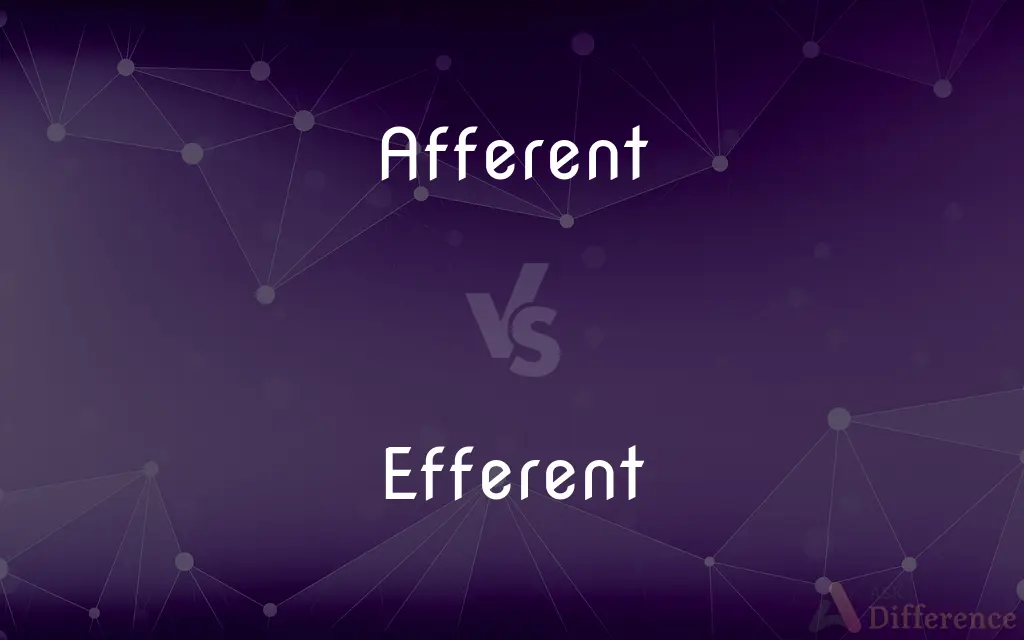Afferent vs. Efferent — What's the Difference?
Edited by Tayyaba Rehman — By Fiza Rafique — Updated on September 21, 2023
Afferent refers to the flow of information or substances toward a central point while Efferent, on the other hand, denotes the outward flow from a central point.

Difference Between Afferent and Efferent
Table of Contents
ADVERTISEMENT
Key Differences
In biological systems, Afferent pathways conduct signals toward a central organ or point. For example, afferent neurons carry sensory information from the body's periphery to the central nervous system. These pathways serve as the "input" channels for the central organ, whether that be the brain, heart, or some other structure.
Efferent pathways work in the opposite direction, carrying signals away from a central organ or point to the periphery. Efferent neurons, for example, transmit motor commands from the brain to muscles and glands. These pathways act as the "output" channels, executing the commands or responses initiated by the central system.
In medical and physiological contexts, Afferent is often used to describe blood vessels, nerves, or lymphatics that carry fluids and signals toward an organ. For example, afferent arterioles in the kidney carry blood to the glomeruli for filtration.
Conversely, Efferent is used to describe structures that carry fluids or signals away from an organ. Efferent arterioles in the kidney, for example, carry filtered blood away from the glomeruli. Similarly, efferent nerves might carry signals from the brain to induce muscle contractions.
Both Afferent and Efferent are crucial terms for understanding the flow of information and substances in biological systems. While afferent processes often precede efferent ones—such as sensory information leading to a motor response—the two are part of a complex, interconnected network that allows organisms to interact with their environments.
ADVERTISEMENT
Comparison Chart
Direction of Flow
Toward a central point
Away from a central point
Common Usage
In nerves, blood vessels
In nerves, blood vessels
Associated Functions
Sensory information
Motor commands
Medical Context
Afferent arterioles
Efferent arterioles
Sequence in Systems
Usually precedes efferent
Usually follows afferent
Compare with Definitions
Afferent
Relating to the movement toward a central point.
Afferent neurons carry information to the brain.
Efferent
Commonly used in biological systems.
Efferent signals lead to muscle contraction.
Afferent
Pertains to sensory information.
Afferent signals from the eyes reach the brain.
Efferent
Pertains to motor commands or actions.
Efferent pathways carry motor information.
Afferent
Often used in a biological context.
Afferent blood vessels deliver blood to the heart.
Efferent
Relating to the movement away from a central point.
Efferent neurons send commands to the muscles.
Afferent
Common in medical and physiological descriptions.
The afferent arterioles carry blood to the kidney's glomeruli.
Efferent
Used to describe various medical structures.
Efferent lymphatic vessels carry lymph away from an organ.
Afferent
Usually precedes efferent actions in systems.
Afferent pathways often initiate efferent responses.
Efferent
Usually follows afferent actions in biological systems.
Efferent responses are often triggered by afferent signals.
Afferent
Conducting or conducted inwards or towards something (for nerves, the central nervous system; for blood vessels, the organ supplied).
Efferent
Conducted or conducting outwards or away from something (for nerves, the central nervous system; for blood vessels, the organ supplied)
Efferent neurons carry impulses outwards to the effector organs
Afferent
An afferent nerve fibre or vessel.
Efferent
An efferent nerve fibre or vessel.
Afferent
Carrying inward to a central organ or section, as nerves that conduct impulses from the periphery of the body to the brain or spinal cord.
Efferent
Directed away from a central organ or section.
Afferent
Carrying towards.
An afferent nerve carries impulses from the body to the brain.
Efferent
Carrying impulses from the central nervous system to an effector.
Afferent
An afferent structure or connection
Efferent
An efferent organ or body part, such as a blood vessel.
Afferent
Bearing or conducting inwards to a part or organ; - opposed to efferent; as, afferent vessels; afferent nerves, which convey sensations from the external organs to the brain.
Efferent
Carrying away from.
An efferent nerve carries impulses from the brain to the body.
Afferent
Of nerves and nerve impulses; conveying sensory information from the sense organs to the CNS;
Afferent nerves
Afferent impulses
Efferent
Carried outward.
Efferent impulses are those conveyed by the motor or efferent nerves from the central nervous organ outwards.
Efferent
A duct or stream that carries away.
Efferent
Conveying outward, or discharging; - applied to certain blood vessels, lymphatics, nerves, etc.
Efferent
An efferent duct or stream.
Efferent
Of nerves and nerve impulses; conveying information away from the CNS;
Efferent nerves and impulses
Common Curiosities
What does Efferent mean?
Efferent refers to the flow of information or substances away from a central point, typically in biological systems.
What are Afferent neurons?
Afferent neurons carry sensory information from the body to the central nervous system.
What are Efferent neurons?
Efferent neurons carry motor commands from the brain to the muscles.
Is Afferent related to sensory functions?
Yes, afferent pathways often carry sensory information to a central system.
Can Afferent and Efferent refer to blood flow?
Yes, they can describe the direction of blood flow in vessels.
What does Afferent mean?
Afferent refers to the flow of information or substances toward a central point, often in a biological context.
Can Afferent and Efferent be used in non-biological contexts?
While most commonly used in biology and medicine, they could be metaphorically applied to other systems.
Is Efferent related to motor functions?
Yes, efferent pathways typically carry motor commands away from a central system.
Are Afferent and Efferent opposites?
In terms of direction, yes. Afferent is toward a central point, while efferent is away from it.
What is an example of an Efferent vessel?
An efferent arteriole in the kidney carries blood away from the glomeruli.
Do Afferent actions usually precede Efferent ones?
Generally, yes. Afferent pathways often provide the information that leads to efferent responses.
Are Afferent and Efferent used in psychological terms?
They are most commonly used in physiology, but their concepts can be extended to psychological processes.
Are Afferent and Efferent layman’s terms?
No, they are specialized terms most often used in scientific and medical contexts.
What is an example of an Afferent vessel?
An afferent arteriole in the kidney carries blood toward the glomeruli.
Are these terms internationally recognized?
Yes, afferent and efferent are globally recognized terms, especially in the scientific community.
Share Your Discovery

Previous Comparison
Lehenga vs. Saree
Next Comparison
Mineral vs. OreAuthor Spotlight
Written by
Fiza RafiqueFiza Rafique is a skilled content writer at AskDifference.com, where she meticulously refines and enhances written pieces. Drawing from her vast editorial expertise, Fiza ensures clarity, accuracy, and precision in every article. Passionate about language, she continually seeks to elevate the quality of content for readers worldwide.
Edited by
Tayyaba RehmanTayyaba Rehman is a distinguished writer, currently serving as a primary contributor to askdifference.com. As a researcher in semantics and etymology, Tayyaba's passion for the complexity of languages and their distinctions has found a perfect home on the platform. Tayyaba delves into the intricacies of language, distinguishing between commonly confused words and phrases, thereby providing clarity for readers worldwide.













































